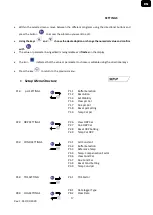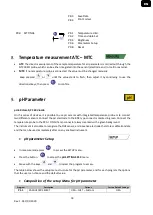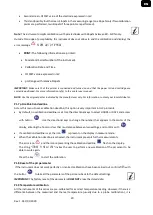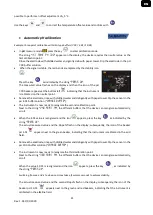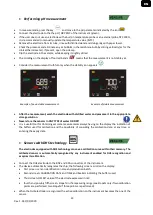
23
Rev. 1.0 31/01/2020
EN
•
Performing pH measurement
•
In measure mode, press the key
and move to the pH parameter indicated by the icon
.
•
Connect the electrode to the the pH / ORP BNC of the instrument (green).
•
If the user does not use an electrode with a built-in temperature probe or an external probe NTC 30K
Ω
,
it is recommended to manually update the temperature value (MTC).
•
Remove the electrode from its tube, rinse with distilled water and dab gently with paper towel.
•
Check the presence and eliminate any air bubbles in the membrane bulb by stirring vertically (as for the
clinical thermometer). If present, open the side cap.
•
Dip the electrode in the sample, while keeping it slightly stirred.
•
The scrolling on the display of four red bands
means that the measurement is not stable yet.
•
Consider the measurement truthful only when the stability icon appears
.
Example of an unstable measurement
Example of stable measurement
•
After the measurement, wash the electrode with distilled water and preserve it in the appropriate
storage solution.
•
Never store the sensors in ANY TYPE of water OR DRY!
•
It is a useful tool for obtaining accurate measurements always having on the display the indication of
the buffers used for calibration and the possibility of consulting the calibration data, at any time, or
entering the expiry date.
•
Sensors with DHS technology
The electrodes equipped with DHS technology can save a calibration curve within their memory. The
calibrated sensor is automatically recognized by any instrument enabled for DHS recognition and
acquires its calibration.
•
Connect the DHS electrode to the BNC and RCA connectors of the instrument.
•
The device automatically recognizes the chip; the following screens scroll on the display:
•
First screen: sensor identification name and production batch.
•
Second screen: CALIBRATION DATE and TIME and beakers indicating the buffers used;
•
Third screen: OFFSET value of the electrode expressed in mV.
•
fourth and possibly fifth screen: Slope% in the measuring range (one Slope% only if two calibration
points are performed, two Slope% if three points are performed).
•
When the DHS electrode is recognized, the active calibration on the instrument becomes the one of the
sensor.









